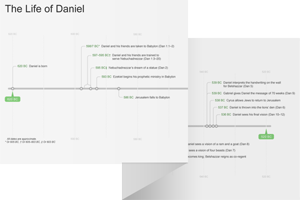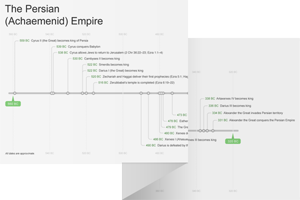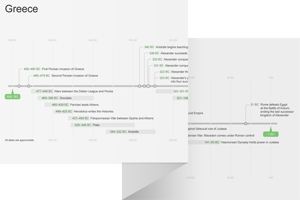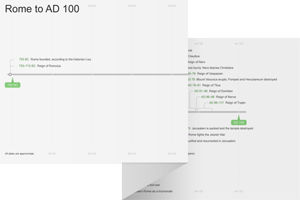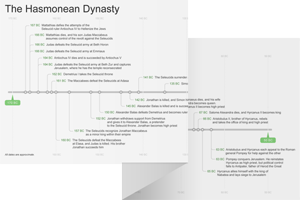7:1–8 Daniel 7 marks the beginning of a new genre. While chs. 1–6 are narrative, chs. 7–12 are categorized as apocalyptic literature. The remainder of the book presents a series of Daniel’s visions and their interpretations. Each new vision adds further revelation and looks forward to a time beyond Daniel’s life. Those undergoing the persecution described in Daniel’s visions could refer to this book to learn how to act and persevere based on his life in Babylon. The future focus of Daniel’s visions, emphasizing events surrounding the persecution of the Jews by Antiochus IV Epiphanes in the second century bc, is a key part of the debate over when Daniel was written. On one hand, it is unremarkable that an inspired prophet could provide testimony of events yet to come. On the other hand, the level of historical detail of some of the visions, especially ch. 11, is unusual for biblical prophecy. |
•
Antiochus |
7:1 the first year of Belshazzar Approximately 550 bc. The first vision is placed within the reign of Belshazzar, the king of Babylon in ch. 5. See 5:1 and note.
he wrote down Apocalyptic literature is often written down and saved for subsequent generations (see Rev 1:11, 19).
7:2 I was looking in my vision in the night One major difference between the narratives and the visions is that Daniel is mentioned in third-person voice in the stories, but the visions are told from a first-person perspective.
the four winds of heaven Indicative of the four points on a compass: north, south, east, and west. The imagery is apparently borrowed from Zech 6:5–7.
the great sea The sea is often used throughout the Hebrew Bible as a symbol of turmoil and chaos.
7:3 four great beasts This first vision recasts the components of the statue from Nebuchadnezzar’s vision in ch. 2 as four beasts, symbolizing four kingdoms. As in ch. 2, the four kingdoms can be interpreted as either Babylon, Media, Persia, and Greece, or Babylon, Media-Persia, Greece, and Rome. See note on 2:31.
Persia, and Greece, or Babylon, Media-Persia, Greece, and Rome. See note on 2:31.
Beasts | Kingdoms from Daniel 2 |
Lion with Eagle’s Wings | Babylon, Head of Gold |
Bear | Media (or Media-Persia), Chest and Arms of Silver |
Leopard with Four Wings and Heads | Persia (or Greece), Middle and Thighs of Bronze |
Ten-horned Beast with Iron Teeth | Greece (or Rome), Legs and Feet of Iron and Clay |
differing from one another There are four different beasts, unlike those in Ezek 1:4–14.
7:4 The first was like a lion Corresponds to the head of gold in Dan 2:32, 37–38, representing Babylon or Nebuchadnezzar.
or Nebuchadnezzar.
wings were plucked off Perhaps a reference to Nebuchadnezzar’s humiliation, punishment, and restoration in 4:28–33, 36–37.
7:5 another beast, a second one Corresponds to the chest and arms of silver in 2:32, 39 and could refer to the Median Empire. Alternatively, this may be a combination of two empires (Medo-Persia).
it was raised up on one side May indicate some sort of physical anomaly or posture—the beast was raised up on its hind feet in a fighting position.
three tusks May refer to tusks or fangs. This makes sense in light of the command to arise and devour.
7:6 like a leopard Corresponds to the middle and thighs of bronze in 2:32, 39. This is likely the Persian Empire, not Greece (for Greece, see vv. 7–8).
not Greece (for Greece, see vv. 7–8).
four heads May foreshadow the four Persian kings in 11:2.
7:7 beast, terrifying and frightful Corresponds to the legs and feet in 2:33, 40–43. Most likely a reference to Greece, though Rome
though Rome is also possible (see 2:40 and note). Compare 7:5 and note.
is also possible (see 2:40 and note). Compare 7:5 and note.
was different from all the other beasts Unlike the other Mesopotamian kingdoms, Greece was from the Mediterranean. This may also reference Greece’s long-lasting influence on the cultures of the world.
ten horns Identified as 10 kings (see v. 24 and note). Horns symbolized might and power in antiquity (e.g., Deut 33:17; 2 Sam 22:3; Psa 18:2; Zech 1:18–21; compare 1 Enoch 90:9; and the Rule of Blessings [1QSb] 5.26 from the Dead Sea Scrolls).
7:8 another little horn The descriptor “little” is derogatory. The close recounting of the deeds of Antiochus throughout the remaining visions suggests that the little horn likely refers to him. However, if Rome is the fourth beast, this horn may alternatively represent the antichrist.
plucked up See Dan 7:24 and note.
7:9–12 The description of the beasts and the little horn prompts the arrival of the Ancient of Days. He passes judgment and makes way for “one like a son of man” (v. 13). Many of the descriptive elements for the Ancient of Days are echoed in the pseudepigraphical |
7:9 an Ancient of Days A reference to God. Similar terminology is used in an Aramaic version of the book of Job from the Dead Sea Scrolls (see 11QtgJob 28.3–4). Compare Job 36:26.
is used in an Aramaic version of the book of Job from the Dead Sea Scrolls (see 11QtgJob 28.3–4). Compare Job 36:26.
clothing was like white snow The typical color of the clothing of heavenly beings (see Matt 28:3; Mark 9:2–3; Rev 3:5).
the hair of his head was like pure wool See Rev 1:14; compare the extrabiblical work 1 Enoch 46:1.
his throne was a flame of fire See Ezek 1:4; compare 1 Enoch 14:22.
 Fire as a Motif of Divine Presence
Fire as a Motif of Divine Presence
its wheels were burning fire See Ezek 1:15–21; compare 1 Enoch 14:18.
7:10 A stream of fire issued forth Compare the extrabiblical work 1 Enoch 14:19.
The judge sat God sitting as judge over creation is a common biblical motif (e.g., 1 Sam 2:10; 1 Chr 16:14; Pss 94:2; 96:13).
over creation is a common biblical motif (e.g., 1 Sam 2:10; 1 Chr 16:14; Pss 94:2; 96:13).
and the books were opened Books containing records of human deeds are common throughout the Bible (e.g., Psa 69:28; Isa 65:6; Mal 3:16; Rev 20:12).
7:11 the beast was slain A judicial act (see Dan 7:10).
7:12 a prolongation of their life was given to them They did not merit the same sort of destruction that the conduct of the fourth beast demanded.
7:13–14 Following the judgment by the Ancient of Days, a human messianic figure appears. He is presented before the Ancient One and given a dominion that will never pass away. |
7:13 like a son of man was coming The Aramaic phrase used here is an idiom that can be translated as “one like a human being.” Jesus adopts this phrase as a title (“Son of Man”).
7:14 kingship The references to kingdom and dominion in this verse are what the Jews were anticipating. They sought an end to the world’s kingdoms by the establishment of God’s kingdom, which also meant an end to their suffering. It did not happen in Daniel’s lifetime, but those undergoing the persecution by Antiochus could hope for it in theirs. This kingdom concept is carried into the Gospels.
7:15–28 For the first time in the book, Daniel could not make sense of a vision and needed someone to explain it to him. He questions one of the throne room attendants, who clarifies the meaning of the beasts and the little horn. The account ends with the anticipation of God’s kingdom and a glimmer of hope. The vision will be expanded upon in later chapters. |
7:15 my spirit was troubled within A common response to the visionary experience (Gen 41:8; Dan 2:1; 4:5, 19; 7:28; 8:27; 10:8, 15–19; Rev 1:17).
7:16 I approached one of the attendants Perhaps Gabriel (see Dan 9:21).
I asked him about the truth The one who previously interpreted dreams now needs to have his vision explained to him. This is a typical feature of apocalyptic literature.
7:17 great beasts which are four in number are four kings The four kings represent four kingdoms; see v. 3 and note.
7:18 the holy ones of the Most High The Aramaic word used here is probably an inclusive term referring to saints and angels. After the four kingdoms reach their peak and decline, a kingdom will be given to the Jews. Jews understood the sequence of events as suffering under foreign nations, God’s judgment, and the establishment of an eternal messianic kingdom.
7:19 I desired to make certain Daniel lists his questions in vv. 19–20.
7:21 this horn made war with the holy ones Represents the persecution of the Jews under Antiochus.
7:22 gave judgment See vv. 9–12.
the holy ones took possession of the kingdom See vv. 13–14.
7:23 the fourth kingdom See v. 7 and note.
7:24 ten kings will arise These may be 10 Seleucid rulers. While seven of these rulers are easily identifiable, the other three are unknown. The number 10 may also be a round symbolic number, which is a common feature in apocalyptic literature. For those who believe the fourth beast is Rome, the 10 horns may represent a 10-nation confederation that will arise during a seven-year tribulation period preceding Christ’s return.
another will arise after them The “little horn” (see v. 8).
he will subdue three kings In an effort to attain the throne, the “little horn” will be instrumental in removing three other kings.
7:25 he will speak words against Antiochus referred to himself as “God Incarnate” on some of the coins he minted. The Jews considered such a designation to be blasphemous (e.g., John 10:33).
he will attempt to change times and law Compare 1 Maccabees 1:45 and the suspension of Jewish religious observance.
for a time and two times and half a time The approximate duration of Antiochus’ Jewish persecution—three-and-a-half years. If the little horn is the antichrist, this is the final three-and-a-half years of the tribulation period.
7:26 the court will sit See Dan 7:10–11.
7:27 an everlasting kingdom Daniel does not elaborate on the details of this kingdom. His focus is not on the kingdom itself; it is on the fact that the Gentile kingdoms and the persecution associated with them will come to an end.
7:28 the end of the account The first apocalyptic vision concludes.
and my face changed Daniel turned pale from fear and distress (see 5:6 and note).

|
About Faithlife Study BibleFaithlife Study Bible (FSB) is your guide to the ancient world of the Old and New Testaments, with study notes and articles that draw from a wide range of academic research. FSB helps you learn how to think about interpretation methods and issues so that you can gain a deeper understanding of the text. |
| Copyright |
Copyright 2012 Logos Bible Software. |
| Support Info | fsb |
 Loading…
Loading…
 Antiochus
Antiochus 
